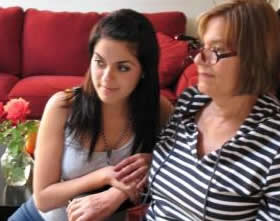Why Use Low Tech?
Low Tech During Certain Stages of the Disease Process (Progressive Disabilities)

Some people with a progressive speech disability may find that they rely on low tech communication more heavily during certain stages of the disease process. This may especially be true during the beginning and end stages of the disease. Some possible reasons for this:
Beginning Stages- Augmenting Speech
Many people with a progressive speech disability will try and use natural speech for as long as possible. These individuals may use low tech spelling strategies (both aided and unaided) to augment their speech, and to keep communicating by using speech for as long as possible.
Beginning Stages- Simplicity/Efficiency
Some people may initially find it more faster and more efficient to use a low tech system (such as hand writing) than a high tech system.
Beginning Stages- While Learning High Tech
Some people may rely more heavily on low tech, while they are learning their high tech system.
Advanced Stages
Communication takes work. Some people at the advanced stage of a progressive disease may have limited energy. By using a low tech communication system, the communication partner can help take over some of the “work load” of communication.
(Click on the tabs Below to open and close)
When his speech became too difficult for his partner to understand, he transitioned to using his communication device.
Eleanor had bulbar onset ALS. (Her speech was the first part of her body which was affected . For a year or so after diagnosis she was still able to walk, use her hands, etc.)
For a long time Eleanor felt that writing was the most efficient way for her to communicate. She was a slow typist, but a fast writer. She used hand writing for most of her face to face communication with her daughter.
As her hands grew weaker, she found it difficult to write, but much easier to push the keys on the keyboard of her communication device. She transitioned to using her communication device, and used it very efficiently.
Near the end of her life, Eleanor and her family used a partner assisted scanning board for communication.
Theoretically, Eleanor could have performed scanning on a computer, but her energy level was very low. Eleanor felt that scanning on the computer required required too much concentration. She said that she felt that her daughter was "smarter" than the computer system, and could figure out better when she was trying to make a selection.
During the last month of her life, It wasn’t important to Eleanor that she be able to communicate independently - she just wanted it to be easy. Her family was devoted to her, and there was always someone around who could help with communication.

